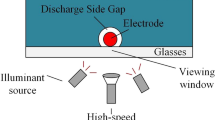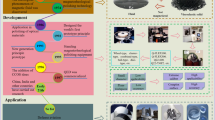Abstract
In order to further improve the surface quality of electrochemical machining multi-stage internal cone hole parts, the method of rotating magnetic field–assisted electrochemical machining is proposed in this paper, a new cathode structure which inlaid Nd-Fe-B permanent magnet on the side wall was designed, and the simulation study on the effect of the magnetic field on the uniformity of the flow field in the machining gap was carried out. Under the conditions of 7 V, 5 mm/min cathode feed speed, 0.15 r/s cathode rotation speed, composition electrolyte 5%NaCl+15%NaNO3+5%NaClO3, electrolyte temperature 30°C, and inlet pressure 1.6 MPa, a comparative experiment of electrochemical machining with and without a rotating magnetic field was conducted. The results show that under the same machining parameters, when there is no magnetic field, the surface roughness of the workpiece is Ra0.847μm, while when a rotating magnetic field is added, the surface roughness of the workpiece is Ra0.437μm. The workpiece surface quality of the multi-stage internal cone hole is improved by 48.41%. It indicates that the rotating magnetic field can change the flow direction of the electrolyte and improve the uniformity of the flow field in the machining gap. Adding a rotating magnetic field is an effective method to improving the surface quality of electrochemical machining.















Similar content being viewed by others
Availability of data and materials
All data generated or analysed during this study are included in this published article.
References
Wang GQ, Li HS, Zhang C, Zhu D (2019) Improvement of machining consistency during through-mask electrochemical large-area machining. Chin J Aeronaut 32(04):1051–1058
Liu J, Wang H, Zhu D (2018) Electrochemical machining of γ-TiAl intermetallic blades by using the stainless steel anti-copied tool electrodes. Procedia CIRP 68:757–761
Geng XS, Suo YG, Song GX (2019) Electrochemical machining of superalloy components with large-sized and spatial curved surface. Electromachining & Mould 05:33–37 (in Chinese)
El-Hofy H (2019) Vibration-assisted electrochemical machining: a review. Int J Adv Manuf Technol 105(1-4):579–593
Wang F, Xiao J, Yue L, Wu XY, Zhao JS (2020) Common key technology of precise electrochemical machining and its application in aviation manufacturing. Electromachining & Mould 01:1–6 (in Chinese)
Tang L, Feng X, Zhai KG, Ji Y, Wang Z, Lei QB, Ren L (2019) Gap flow field simulation and experiment of electrochemical machining special-shaped inner spiral tube. Int J Adv Manuf Technol 100(9-12):2485–2493
Yao J, Chen ZT, Nie YJ, Wang F (2019) Flow field design and experimental study of electrochemical machining using thin hollow cathodes. Proc Inst Mech Eng 233(3):766–775
Hu XY, Zhu D, Li JB, Gu ZZ (2019) Flow field research on electrochemical machining with gas film insulation. J Mater Process Technol 267:247–256
Luo HP, Liu GX, Zhang YJ, Zhang CY, Natsu W (2018) Flow field design and experiments on pulse ECM of large-lead ball nut raceway during tool cutting-out Stage. Procedia CIRP 68:690–693
Liu GX, Zhang YJ, Wataru N (2019) Influence of electrolyte flow mode on characteristics of electrochemical machining with electrolyte suction tool. Int J Mach Tools Manuf 142:66–75
Yang F, Ren TY, Wang HB, Liu BX, Chen M (2017) Analysis of flow field for electrochemical machining metal screw pump stator. Int J Adv Manuf Technol 89(5-8):1317–1326
Chen YL, Zhou XC, Chen PX, Wang ZQ (2019) Numerical simulation study on temperature field of ECM based on the turbulent SST model. J Mech Eng 55(17):215–221 (in Chinese)
Wang F, Zhao JS, Lv YM, Fu XQ, Kang M, Tian ZJ (2020) Sheet cathode design and experimental study on the electrochemical machining of deep narrow slots in TB6 titanium alloy. Proc Inst Mech Eng 234(4):801–813
Zhu D, Liu C, Xu ZY, Liu J (2016) Cathode design investigation based on iterative correction of predicted profile errors in electrochemical machining of compressor blades. Chin J Aeronaut 29(4):1111–1118
Lv YM, Zhao JS, Fan YT, Liu DM, Yang ZW (2018) Cathode structure design of electrochemical machining for deep narrow grooves with high length-width ratio. Aeronaut Manuf Technol 61(03):46–53 (in Chinese)
Tang L, Zhu QL, Zhao JS, Fan ZJ (2017) Research on the cathode design and experiments of electrochemical machining a closed impeller internal flow channel. Int J Adv Manuf Technol 88:2517–2525
Xu ZY, Liu J, Xu Q, Gong T, Zhu D, Qu NS (2015) The tool design and experiments on electrochemical machining of a blisk using multiple tube electrodes. Int J Adv Manuf Technol 79(1-4):531–539
Zhou C, Zhang YJ, Liu GX, Wu M, Yao YB (2016) Experimental study on cathode optimized ECM-shaped hole. Electromachining & Mould 03:20-23+32. (in Chinese)
He YF, Gan WM, Yin FH, Zhao JS, Xu B, Wu XF (2019) Effect of cathode feed mode on electrochemical machining of diamond hole. Int J Electrochem Sci 14:11651–11662
Qu NS, Xu ZY (2013) Improving machining accuracy of electrochemical machining blade by optimization of cathode feeding directions. Int J Adv Manuf Technol 68(5-8):1565–1572
Pan Y, Xu LZ (2015) Vibration analysis and experiments on electrochemical micro-machining using cathode vibration feed system. Int J Precis Eng Manuf 16(1):143–149
Judal KB, Vinod Y (2013) Modeling and simulation of cylindrical electro-chemical magnetic abrasive machining of AISI-420 magnetic steel. J Mater Process Technol 213:2089–2100
Ernst A, Heib T, Hall T, Schmidt G, Bahre D (2018) Simulation of the electrochemical machining of jet engine vanes. 19th CIRP Conference on Electro Physical and Chemical Machining 23-27.
Zhu D, Zhou ZG, Xue TY, Liu A (2017) Simulation and experimental investigation on a dynamic lateral flow mode in trepanning electrochemical machining. Chin J Aeronaut 30(04):1624–1630
Li L, BJ M, Wang RF, Du LQ (2017) The coupled effect of magnetic field, electric field, and electrolyte motion on the material removal amount in electrochemical machining. Int J Adv Manuf Technol 91(9-12):2995–3006
Li L, BJ M (2018) Effect of magnetic field on anodic dissolution in electrochemical machining. Int J Adv Manuf Technol 94(1):1177–1187
Li L, BJ M, Cheng PY, Yun K, Yin PL (2019) Effect of magnetic field on the electrochemical machining localization. Int J Adv Manuf Technol 102(1):949–956
Ayyappan S, Sivakumar K, Kalaimathi M (2017) Electrochemical machining of 20MnCr5 alloy steel with magnetic flux assisted vibrating tool. Proc Inst Mech Eng 231(10):1956–1965
Peruri SR, Chaganti PK (2019) A review of magnetic-assisted machining processes. J Braz Soc Mech Sci Eng 41(10):1–17
Wang XP, Zhao JJ, Hu YP, Li L, Wang C (2014) Effects of the Lorentz force and the gradient magnetic force on the anodic dissolution of nickel in HNO3+NaCl solution. Electrochim Acta 117:113–119
Yuan BY, Wang C, Li L, Chen SH (2012) Investigation of the effects of the magnetic field on the anodic dissolution of copper in NaCl solutions with holography. Corros Sci 58:69–78
Pa PS (2009) Super finishing with ultrasonic and magnetic assistance in electrochemical micro-machining. Electrochim Acta 54:6022–6027
Lin MY, Tsai TH, Hourng LW, Wang WK (2019) The effects of magnetic field and ethanol addition on the electrochemical discharge machining. Int J Adv Manuf Technol 105(5-6):2461–2467
Fan ZJ, Wang GG, Tang L, Wang TC (2010) Design of device and experiment on magnetic field assisted electrochemical machining. J Mech Eng 46(1):194–198 (in Chinese)
Fang ZJ, Zhang LX, Tang L (2008) Influence of magnetic field on accuracy of ECM by changing the conductivity of anode film. Chin J Mech Eng 04:11–14
Tang L, Gan WM (2014) Experiment and simulation study on concentrated magnetic field-assisted ECM S-03 special stainless steel complex cavity. Int J Adv Manuf Technol 72(5-8):685–692
Funding
This work was financially supported by Shaanxi Province Key Research and Development projects (Grant No. 2020GY-153), Shaanxi Provincial Education Department service local special plan project (Grant No. 17JF010), the National Natural Science Foundation of Shaanxi (Grant No. 2019JM-579), Key Laboratory of Science and Technology innovation project of Shaanxi Province (Grant No. 2014SZS20-Z01, No. 2014SZS20-P05) and the Open Research Fund Program of Shaanxi Key Laboratory of Non-Traditional Machining (Grant No. 2015SZSj-61-6).
Author information
Authors and Affiliations
Contributions
Kaige Zhai was the main contributor to the manuscript, and Lin Tang is the corresponding author of this manuscript. Under the guidance of Professor Lin Tang, Kaige Zhai, Yongning Yan and Xin Feng proposed the rotating magnetic field–assisted electrochemical machining method, designed the cathode structure and carried out the simulation study of gap flow field. Jia Liu and Xinyun Zhang participated in the rotating magnetic field–assisted electrochemical machining experiment and guided the manuscript writing.
Corresponding author
Ethics declarations
Ethics approval
Not applicable
Consent to participate
Not applicable
Consent for publication
Not applicable
Conflict of interest
The authors declare no competing interests.
Additional information
Publisher’s note
Springer Nature remains neutral with regard to jurisdictional claims in published maps and institutional affiliations.
Rights and permissions
About this article
Cite this article
Zhai, K., Tang, L., Liu, J. et al. Study on improving the surface roughness of multi-stage internal cone hole by rotating magnetic field assisted electrochemical machining. Int J Adv Manuf Technol 115, 1227–1236 (2021). https://doi.org/10.1007/s00170-021-06930-w
Received:
Accepted:
Published:
Issue Date:
DOI: https://doi.org/10.1007/s00170-021-06930-w




